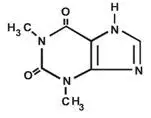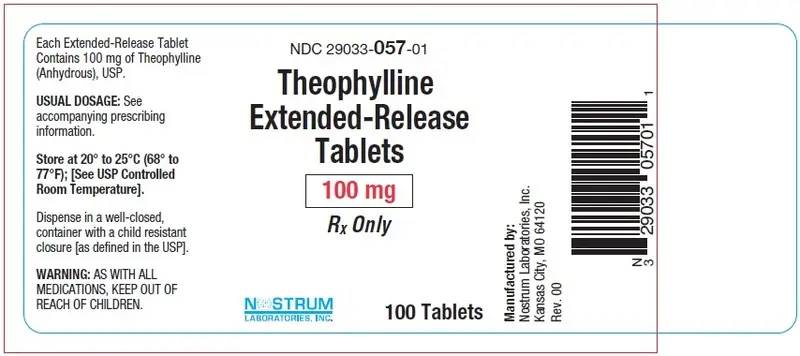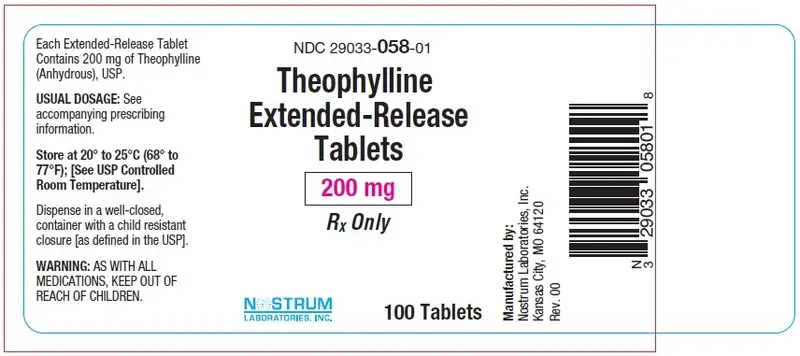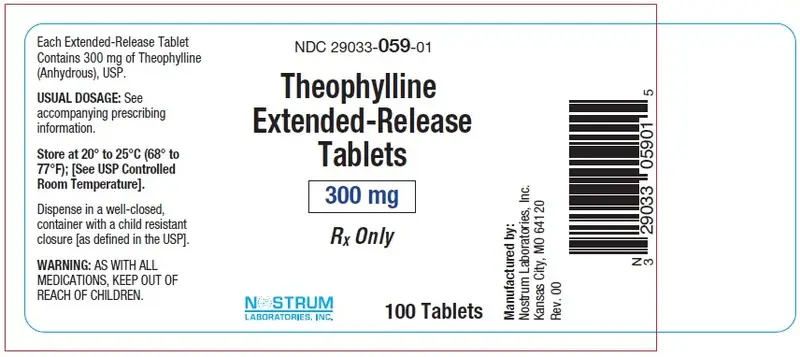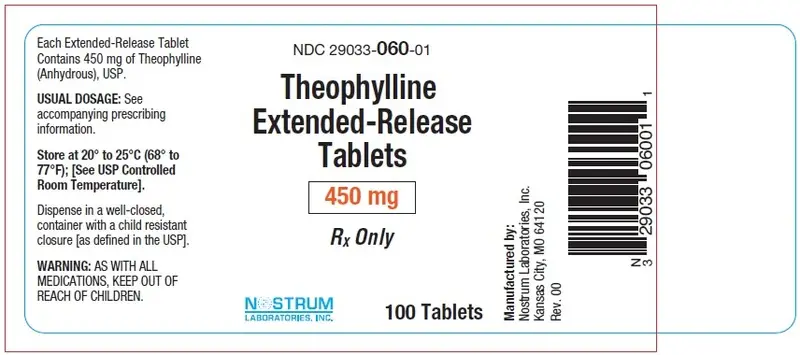Theophylline - Clinical Pharmacology
Mechanism of Action:
Theophylline has two distinct actions in the airways of patients with reversible obstruction; smooth muscle relaxation (i.e., bronchodilation) and suppression of the response of the airways to stimuli (i.e., non-bronchodilator prophylactic effects). While the mechanisms of action of theophylline are not known with certainty, studies in animals suggest that bronchodilation is mediated by the inhibition of two isozymes of phosphodiesterase (PDE III and, to a lesser extent, PDE IV) while non-bronchodilator prophylactic actions are probably mediated through one or more different molecular mechanisms, that do not involve inhibition of PDE III or antagonism of adenosine receptors. Some of the adverse effects associated with theophylline appear to be mediated by inhibition of PDE III (e.g., hypotension, tachycardia, headache, and emesis) and adenosine receptor antagonism (e.g., alterations in cerebral blood flow).
Theophylline increases the force of contraction of diaphragmatic muscles. This action appears to be due to enhancement of calcium uptake through an adenosine-mediated channel.
Serum Concentration-Effect Relationship:Bronchodilation occurs over the serum theophylline concentration range of 5-20 mcg/mL. Clinically important improvement in symptom control has been found in most studies to require peak serum theophylline concentrations > 10 mcg/mL, but patients with mild disease may benefit from lower concentrations. At serum theophylline concentrations > 20 mcg/mL, both the frequency and severity of adverse reactions increase. In general, maintaining peak serum theophylline concentrations between 10 and 15 mcg/mL will achieve most of the drug's potential therapeutic benefit while minimizing the risk of serious adverse events.
Pharmacokinetics:
Overview: Theophylline is rapidly and completely absorbed after oral administration in solution or immediate-release solid oral dosage form. Theophylline does not undergo any appreciable pre-systemic elimination, distributes freely into fat-free tissues and is extensively metabolized in the liver.
The pharmacokinetics of theophylline vary widely among similar patients and cannot be predicted by age, sex, body weight or other demographic characteristics. In addition, certain concurrent illnesses and alterations in normal physiology (see Table I) and co-administration of other drugs (see Table II) can significantly alter the pharmacokinetic characteristics of theophylline. Within-subject variability in metabolism has also been reported in some studies, especially in acutely ill patients. It is, therefore, recommended that serum theophylline concentrations be measured frequently in acutely ill patients (e.g., at 24-hr intervals) and periodically in patients receiving long-term therapy, e.g., at 6-12 month intervals. More frequent measurements should be made in the presence of any condition that may significantly alter theophylline clearance (see PRECAUTIONS, Laboratory Tests).
Table I. Mean and range of total body clearance and half-life of theophylline related to age and altered physiological states.¶
| Population Characteristics | Total body clearance* mean (range)†† (mL/kg/min) | Half-life mean (range)††
(hr) |
AgePremature neonates
postnatal age 3-15 days
postnatal age 25-57 days
Term infants
postnatal age 1-2 days
postnatal age 3-30 weeks
Children
1-4 years
4-12 years
13-15 years
6-17 years
Adults (16-60 years)
otherwise healthy
non-smoking asthmatics
Elderly (>60 years)
non-smokers with normal cardiac,
liver, and renal function
Concurrent illness or altered physiological stateAcute pulmonary edema
COPD->60 years, stable
non-smoker >1 year
COPD with cor pulmonale
Cystic fibrosis (14-28 years)
Fever associated with acute viral respiratory illness (children 9-15 years)
Liver disease - cirrhosis
acute hepatitis
cholestasis
Pregnancy - 1st trimester
2nd trimester
3rd trimester
Sepsis with multi-organ failure
Thyroid disease - hypothyroid
hyperthyroid |
0.29 (0.09-0.49)
0.64 (0.04-1.2)
NR†
NR†
1.7 (0.5-2.9)
1.6 (0.8-2.4)
0.9 (0.48-1.3)
1.4 (0.2-2.6)
0.65 (0.27-1.03)
0.41 (0.21-0.61)
0.33** (0.07-2.45)
0.54 (0.44-0.64)
0.48 (0.08-0.88)
1.25 (0.31-2.2)
NR†
0.31** (0.1-0.7)
0.35 (0.25-0.45)
0.65 (0.25-1.45)
NR†
NR†
NR†
0.47 (0.19-1.9)
0.38 (0.13-0.57)
0.8 (0.68-0.97) |
30 (17-43)
20 (9.4-30.6)
25.7 (25-26.5)
11 (6-29)
3.4 (1.2-5.6)
NR†
NR†
3.7 (1.5-5.9)
8.7 (6.1-12.8)
9.8 (1.6-18)
19** (3.1-82)
11 (9.4-12.6)
NR†
6.0 (1.8-10.2)
7.0 (1.0-13)
32** (10-56)
19.2 (16.6-21.8)
14.4 (5.7-31.8)
8.5 (3.1-13.9)
8.8 (3.8-13.8)
13.0 (8.4-17.6)
18.8 (6.3-24.1)
11.6 (8.2-25)
4.5 (3.7-5.6) |
¶ For various North American patient populations from literature reports. Different rates of elimination and consequent dosage requirements have been observed among other peoples.
* Clearance represents the volume of blood completely cleared of theophylline by the liver in one minute. Values listed were generally determined at serum theophylline concentrations <20 mcg/mL; clearance may decrease and half-life may increase at higher serum concentrations due to non-linear pharmacokinetics.
†† Reported range or estimated range (mean 2 SD) where actual range not reported.
† NR = not reported or not reported in a comparable format.
** Median
NOTE:In addition to the factors listed above, theophylline clearance is increased and half-life decreased by low carbohydrate/high protein diets, parenteral nutrition, and daily consumption of charcoal-broiled beef. A high carbohydrate/low protein diet can decrease the clearance and prolong the half-life of theophylline.
Absorption: Theophylline is rapidly and completely absorbed after oral administration in solution or immediate-release solid oral dosage form. After a single dose immediate release theophylline of 5 mg/kg in adults, a mean peak serum concentration of about 10 mcg/mL (range 5-15 mcg/mL) can be expected 1-2 hour after the dose. Co-administration of theophylline with food or antacids does not cause clinically significant changes in the absorption of theophylline from immediate-release dosage forms.
Single-Dose Study:
(450 mg)
A single-dose, two-way crossover study was conducted in sixteen healthy male volunteers under fasting conditions with one 450 mg tablet being administered at 7 a.m. with a 6 oz. glass of water. No food or liquid (other than water) was allowed for 4 hours after which a standard lunch was served. Mean peak theophylline serum levels (Cmax ) was 6.69 mcg/mL and mean time of peak serum concentration (Tmax ) was 8.31 hours.
(300 mg)
A single-dose crossover study was conducted in twelve healthy male volunteers to compare pharmacokinetic parameters when theophylline extended-release tablets were administered with and without food. Subjects were fasted overnight and received a single 300 mg tablet early the following morning.
When dosing was done under fed conditions, the subjects received a standard breakfast consisting of 2 fried eggs, 2 strips of bacon, 4 oz. hash brown potatoes, 1 slice of toast with a pat of butter, and 8 oz. whole milk 15 minutes pre-dosing. No food was allowed for five hours post-dosing, then a standard lunch was served; at ten hours post-dosing a standard supper was served. Mean peak theophylline serum levels for the two treatments were 3.7 mcg/mL (fasting) and 4.4 mcg/mL (with food).The time of peak serum level varied from subject to subject, occurring from 4 to 14 hours after dosing. However, 92% of the subjects had serum levels at least 75% of the maximum value at 4 to 8 hours after dosing, during each phase.
Thus, blood samples taken 4 to 8 hours post-dosing should reference the peak serum level for most patients. The mean Tmax was 6.2 hours (fasting) and 8.7 hours (with food). The respective AUC (0-inf.) for these treatments were 73.3 mcg x hr/mL and 82.2 mcg x hr/mL, respectively.
Multiple-Dose Study:
(300 mg)
A multiple- dose, steady - state study was conducted under fed conditions. Three high fat content meals were served at 6:30 a.m., 12 noon and 6:30 p.m. Nineteen normal subjects were dosed at 300 mg every 12 hours (7 p.m. and 7 a.m.) for eight doses. Dosing began one-half hour after the evening meal with the test dose occurring one-half hour after breakfast. At steady-state, the mean peak concentration was 8.8 mcg/mL and the mean trough concentration was 5.9 mcg/mL.
The time of peak concentration (Tmax) was 6.2 hours. The average percent fraction of fluctuation [(Cmax -Cmin /Cmin) x 100] was 49% for this formulation and dosing regimen.
The subjects used for this study exhibited a mean half-life of 8.3 hours (range 5.2-12.2) and mean clearance of 3.5 L/hour (range 2.3-5.6) as determined in a separate single-dose clearance study using 500 mg of immediate-release theophylline, prior to this multiple-dose study.
Once-a-Day Dosing:
A multiple-dose, steady-state study was conducted under fed conditions with once-a-day dosing. Fed conditions were the same as those previously cited. Sixteen subjects were dosed as 2 x 300 mg tablets every morning at 8 a.m. for five doses. At steady-state, the mean Cmax was 11.7 mcg/mL, and the mean Cmin was 3.4 mcg/mL. The average percent fraction of fluctuation was 244%. The mean Tmax was 8.7 hours.
The subjects used in the above study exhibited a mean half-life of 7.9 hours (range 5.3-13.4) and a mean clearance of 3.8 L/hour (range 2.3-5.7)
Distribution: Once theophylline enters the systemic circulation, about 40% is bound to plasma protein, primarily albumin. Unbound theophylline distributes throughout body water, but distributes poorly into body fat. The apparent volume of distribution of theophylline is approximately 0.45 L/kg (range 0.3-0.7 L/kg) based on ideal body weight. Theophylline passes freely across the placenta, into breast milk and into the cerebrospinal fluid (CSF). Saliva theophylline concentrations approximate unbound serum concentrations, but are not reliable for routine or therapeutic monitoring unless special techniques are used. An increase in the volume of distribution of theophylline, primarily due to reduction in plasma protein binding, occurs in premature neonates, patients with hepatic cirrhosis, uncorrected acidemia, the elderly and in women during the third trimester of pregnancy. In such cases, the patient may show signs of toxicity at total (bound + unbound) serum concentrations of theophylline in the therapeutic range (10-20 mcg/mL) due to elevated concentrations of the pharmacologically active unbound drug. Similarly, a patient with decreased theophylline binding may have a sub-therapeutic total drug concentration while the pharmacologically active unbound concentration is in the therapeutic range. If only total serum theophylline concentration is measured, this may lead to an unnecessary and potentially dangerous dose increase. In patients with reduced protein binding, measurement of unbound serum theophylline concentration provides a more reliable means of dosage adjustment than measurement of total serum theophylline concentration. Generally, concentrations of unbound theophylline should be maintained in the range of 6-12 mcg/mL.
Metabolism: Following oral dosing, theophylline does not undergo any measurable first-pass elimination. In adults and children beyond one year of age, approximately 90% of the dose is metabolized in the liver. Biotransformation takes place through demethylation to 1-methylxanthine and 3-methylxanthine and hydroxylation to 1,3-dimethyluric acid. 1-methylxanthine is further hydroxylated, by xanthine oxidase, to 1-methyluric acid. About 6% of a theophylline dose is N-methylated to caffeine. Theophylline demethylation to 3-methylxanthine is catalyzed by cytochrome P-450 1A2, while cytochromes P-450 2E1 and P-450 3A3 catalyze the hydroxylation to 1,3-dimethyluric acid. Demethylation to 1- methyl-xanthine appears to be catalyzed either by cytochrome P-450 1A2 or a closely related cytochrome. In neonates, the N-demethylation pathway is absent while the function of the hydroxylation pathway is markedly deficient. The activity of these pathways slowly increases to maximal levels by one year of age.
Caffeine and 3-methylxanthine are the only theophylline metabolites with pharmacologic activity. 3-methylxanthine has approximately one tenth the pharmacologic activity of theophylline and serum concentrations in adults with normal renal function are <1 mcg/mL. In patients with end-stage renal disease, 3-methylxanthine may accumulate to concentrations that approximate the unmetabolized theophylline concentration. Caffeine concentrations are usually undetectable in adults regardless of renal function. In neonates, caffeine may accumulate to concentrations that approximate the unmetabolized theophylline concentration and thus, exert a pharmacologic effect.
Both the N-demethylation and hydroxylation pathways of theophylline biotransformation are capacity-limited. Due to the wide intersubject variability of the rate of theophylline metabolism, non-linearity of elimination may begin in some patients at serum theophylline concentrations >10 mcg/mL. Since this non-linearity results in more than proportional changes in serum theophylline concentrations with changes in dose, it is advisable to make increases or decreases in dose in small increments in order to achieve desired changes in serum theophylline concentrations (see DOSAGE AND ADMINISTRATION, Table VI). Accurate prediction of dose-dependency of theophylline metabolism in patients a priori is not possible, but patients with very high initial clearance rates (i.e., low steady - state serum theophylline concentrations at above average doses) have the greatest likelihood of experiencing large changes in serum theophylline concentration in response to dosage changes.
Excretion: In neonates, approximately 50% of the theophylline dose is excreted unchanged in the urine. Beyond the first three months of life, approximately 10% of the theophylline dose is excreted unchanged in the urine. The remainder is excreted in the urine mainly as 1,3-dimethyluric acid (35-40%), 1-methyluric acid (20-25%) and 3-methylxanthine (15- 20%). Since little theophylline is excreted unchanged in the urine and since active metabolites of theophylline (i.e., caffeine, 3-methylxanthine) do not accumulate to clinically significant levels even in the face of end-stage renal disease, no dosage adjustment for renal insufficiency is necessary in adults and children >3 months of age. In contrast, the large fraction of the theophylline dose excreted in the urine as unchanged theophylline and caffeine in neonates requires careful attention to dose reduction and frequent monitoring of serum theophylline concentrations in neonates with reduced renal function (See WARNINGS).
Serum Concentrations at Steady-State: After multiple doses of theophylline, steady-state is reached in 30-65 hours (average 40 hours) in adults. At steady- state, on a dosage regimen with 6-hour intervals, the expected mean trough concentration is approximately 60% of the mean peak concentration, assuming a mean theophylline half-life of 8 hours. The difference between peak and trough concentrations is larger in patients with more rapid theophylline clearance. In patients with high theophylline clearance and half-lives of about 4-5 hours, such as children age 1 to 9 years, the trough serum theophylline concentration may be only 30% of peak with a 6-hour dosing interval. In these patients a slow-release formulation would allow a longer dosing interval (8-12 hours) with a smaller peak/trough difference.
Special Populations (See Table I for mean clearance and half-life values):
Geriatric: The clearance of theophylline is decreased by an average of 30% in healthy elderly adults (> 60 yrs) compared to healthy young adults. Careful attention to dose reduction and frequent monitoring of serum theophylline concentrations are required in elderly patients (see WARNINGS).
Pediatrics: The clearance of theophylline is very low in neonates (see WARNINGS). Theophylline clearance reaches maximal values by one year of age, remains relatively constant until about 9 years of age and then slowly decreases by approximately 50% to adult values at about age 16. Renal excretion of unchanged theophylline in neonates amounts to about 50% of the dose, compared to about 10% in children older than three months and in adults. Careful attention to dosage selection and monitoring of serum Theophylline concentrations are required in pediatric patients (see WARNINGSand DOSAGE AND ADMINISTRATION).
Gender: Gender differences in theophylline clearance are relatively small and unlikely to be of clinical significance. Significant reduction in theophylline clearance, however, has been reported in women on the 20th day of the menstrual cycle and during the third trimester of pregnancy.
Race: Pharmacokinetic differences in theophylline clearance due to race have not been studied.
Renal Insufficiency: Only a small fraction, e.g., about 10%, of the administered theophylline dose is excreted unchanged in the urine of children greater than three months of age and adults. Since little theophylline is excreted unchanged in the urine and since active metabolites of theophylline (i.e., caffeine, 3-methylxanthine) do not accumulate to clinically significant levels even in the face of end-stage renal disease, no dosage adjustment for renal insufficiency is necessary in adults and children >3 months of age. In contrast, approximately 50% of the administered theophylline dose is excreted unchanged in the urine in neonates. Careful attention to dose reduction and frequent monitoring of serum theophylline concentrations are required in neonates with decreased renal function (see WARNINGS).
Hepatic Insufficiency: Theophylline clearance is decreased by 50% or more in patients with hepatic insufficiency (e.g., cirrhosis, acute hepatitis, cholestasis). Careful attention to dose reduction and frequent monitoring of serum theophylline concentrations are required in patients with reduced hepatic function (see WARNINGS).Congestive Heart Failure (CHF): Theophylline clearance is decreased by 50% or more in patients with CHF. The extent of reduction in theophylline clearance in patients with CHF appears to be directly correlated to the severity of the cardiac disease. Since theophylline clearance is independent of liver blood flow, the reduction in clearance appears to be due to impaired hepatocyte function rather than reduced perfusion. Careful attention to dose reduction and frequent monitoring of serum theophylline concentrations are required in patients with CHF (see WARNINGS).Smokers: Tobacco and marijuana smoking appears to increase the clearance of theophylline by induction of metabolic pathways. Theophylline clearance has been shown to increase by approximately 50% in young adult tobacco smokers and by approximately 80% in elderly tobacco smokers compared to non-smoking subjects. Passive smoke exposure has also been shown to increase theophylline clearance by up to 50%. Abstinence from tobacco smoking for one week causes a reduction of approximately 40% in theophylline clearance. Careful attention to dose reduction and frequent monitoring of serum theophylline concentrations are required in patients who stop smoking (see WARNINGS). Use of nicotine gum has been shown to have no effect on theophylline clearance.
Fever: Fever, regardless of its underlying cause, can decrease the clearance of theophylline. The magnitude and duration of the fever appear to be directly correlated to the degree of decrease of theophylline clearance. Precise data are lacking, but a temperature of 39°C (102°F) for at least 24 hours is probably required to produce a clinically significant increase in serum theophylline concentrations. Children with rapid rates of theophylline clearance (i.e., those who require a dose that is substantially larger than average [e.g., >22 mg/kg/day] to achieve a therapeutic peak serum theophylline concentration when afebrile) may be at greater risk of toxic effects from decreased clearance during sustained fever. Careful attention to dose reduction and frequent monitoring of serum theophylline concentrations are required in patients with sustained fever (see WARNINGS).Miscellaneous: Other factors associated with decreased theophylline clearance include the third trimester of pregnancy, sepsis with multiple organ failure, and hypothyroidism. Careful attention to dose reduction and frequent monitoring of serum theophylline concentrations are required in patients with any of these conditions (see WARNINGS). Other factors associated with increased theophylline clearance include hyperthyroidism and cystic fibrosis.
Clinical Studies:In patients with chronic asthma, including patients with severe asthma requiring inhaled corticosteroids or alternate-day oral corticosteroids, many clinical studies have shown that theophylline decreases the frequency and severity of symptoms, including nocturnal exacerbations, and decreases the “as needed” use of inhaled beta-2 agonists. Theophylline has also been shown to reduce the need for short courses of daily oral prednisone to relieve exacerbations of airway obstruction that are unresponsive to bronchodilators in asthmatics.
In patients with chronic obstructive pulmonary disease (COPD), clinical studies have shown that theophylline decreases dyspnea, air trapping, the work of breathing, and improves contractility of diaphragmatic muscles with little or no improvement in pulmonary function measurements.




